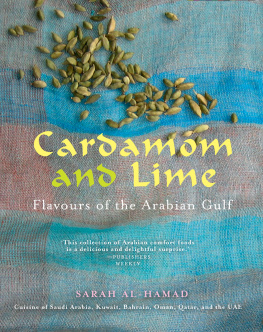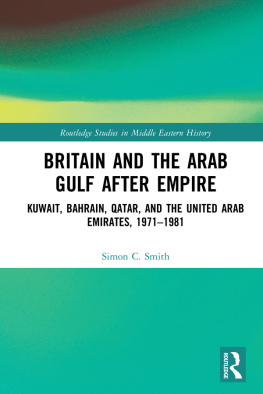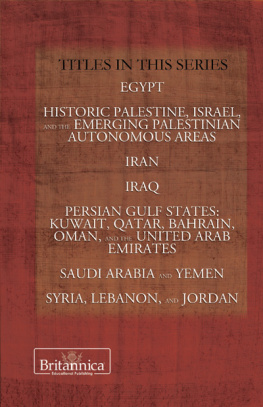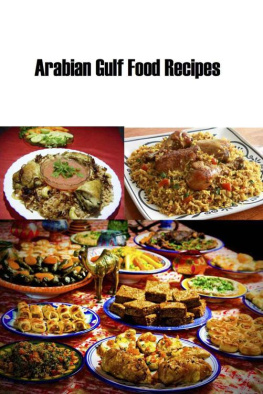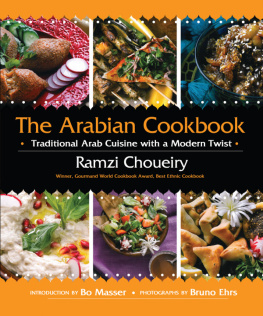Contents
Guide



For baba
Published 2016IMM Lifestyle Books
www.IMMLifestyleBooks.com
IMM Lifestyle Books are distributed in the UK by Grantham Book Service.
Copyright 2008, 2016 text, recipes, location photography: Sarah al-Hamad
Copyright 2008, 2016 recipe photographs: IMM Lifestyle Books
Copyright 2008, 2011, 2016 IMM Lifestyle Books
Sarah al-Hamad has asserted her moral right to be identified as the author of this work.
All rights reserved. No part of this publication may be reproduced, stored in a retrieval system, or transmitted in any form or by any means, electronic, mechanical, photocopying, recording or otherwise, without the prior written permission of the publishers and copyright holders.
eISBN 978 1 6076 5190 1
Printed in Singapore
10 9 8 7 6 5 4 3 2 1

Date seller at souq al-Mubarakiya, Kuwait City

contents

T he ARABIAN GULF: Bahrain, Oman, Kuwait, Qatar, the United Arab Emirates and Saudi Arabia, a cluster of countries dotting the Arabian Sea coast, collectively they are al-Khaleej. This is a book about the food of the Arabian Gulf.
For hundreds of years the deserts and ports of the Arabian peninsula were inhabited by disparate tribes. Originally the bedouin roaming the deserts relied heavily on a diet of dates and dairy products, rarely meat. Life was difficult and there was little by way of natural resources.
In the pre-oil days, the Gulfs main sources of livelihood were pearling and trade. Later the merchants travels brought a wide array of imported food items and methods of cooking. Arabia has long been a centre of trade. Its position on the trade route from Africa to India was fortuitous, and it was on the dhows (traditional Arab sailing vessels) from India that the first spices and ingredients entered the region. Fragrant cardamom pods, cloves, saffron threads, cumin seeds, chilli and curry powder and long-grain basmati rice. The food of the Gulf is largely a combination of Indian, Persian and Turkish cuisine.
Cultures living by the sea (al-bahar) inevitably develop a closeness to it. Wherever you go in the Gulf most khaleeji cities are built up along their coastlines the sea is ever-present and a source of beauty. One of my favourite films is the Kuwaiti Bas ya bahar (1971), a sensitive yet cheerless rendering of life in the days when pearling was the common mans fate; the film beautifully illustrates this give and take with the sea and its dominance in everyday affairs. Pearling is obsolete today but the sea remains a strong symbol of the past. It is still vital to the economies of the area; sea-sports and fishing are also popular.

Alleyway in Muharraq, Bahrain
The Gulf went from relative poverty to astonishing prosperity in the span of a half a century. It now has one of the highest birth rates in the world. Seen as a land of opportunity, the region started attracting South Asians in the 1960s. This phenomenon affected peoples dietary habits. While researching this book, most of the cooks I met were from India or Bangladesh. These migrant workers may live and work for decades in the Gulf, integrating into the families they join. A cooks training involves learning traditional recipes as well as continental dishes like pasta, fancy salads and desserts. A source of pride and envy, cooks are regularly loaned out to friends to teach other cooks a special dish or train newcomers. It is common for households to have a cook, even if the homemaker is a good one herself; families are large and food sharing is central to local life.

Old dhows and fishermen in Fahaheel, Kuwait
To understand food-sharing is to get at the core of the role food plays in mediating social relations in the Gulf. In the olden days, communities were small. Neighbourhoods consisted of houses clustered together and socialising took place mostly among men in an open courtyard, where they gathered and strangers were easily identified. A womans place was firmly in the home, her social affairs confined to relatives and neighbours. Homemaking and childrearing would have been her primary roles. The housewife would cook every day, but always making a little extra to share with neighbours or surprise guests.
In much the same way nowadays, lunch or dinner is offered at happy occasions but also at times of bereavement; relatives and neighbours still engage in food exchanges that can last for years and dishes periodically travelling between homes. Wealthier households with large social networks have a quasidedicated catering system complete with hotel-style stainlesssteel boxes and transport van.
Food also tops the list of gifts to bring back from trips abroad. I remember crates of Alfonso mangos appearing every year at the same time, beautifully ripe and sweet, sent from India by one of my fathers friends, or sacks of pistachios brought back from Iran, honey from Yemen, wonderful sesame-covered biscuits from Syria and Lebanon and dates sent over from Saudi Arabia each country renowned for a special food.
A venue where food makes a strong appearance is the diwan or diwaniyya (also known as the majlis in some countries), that most important of informal social institutions. The diwaniyya is typically a male social space where friends and relatives gather, usually in the evenings, to catch up, talk business or politics, or to gossip. It can be a simple room attached to a persons house, or a lavish hall where weddings and other rites are held. Diwaniyyas are family-specific. In Kuwait, the institution is especially strong and most local families will have one it is a mark of status and prestige. Tea, coffee and fresh juices are a fixture at these gatherings, finger snacks like sambousa (samosas) and batata chab (potato chops) are sometimes offered and dinner is served when the gathering thins out to family members.

No dish typifies Gulf cuisine better than the machbous. Inspired by the magnificent Persian and Indian biryanis, the machbous derives its name from the Arabic for compressed, kabs. It is a cooking method which re-uses the spiced water used to cook meat or fish to suffuse the rice, marrying the ingredients and spices together. The resulting dish is a celebration of robust perfumes and ingredients, scented with cardamom, cloves and cinnamon. There are many types of machbous (pl.

